Explore Sur - Oman Travel, Asia
Nestled along the northeastern coast of Oman, Sur is a coastal city rich in history and tradition. Known for its maritime heritage, Sur has been a thriving port for centuries, connecting Oman with the rest of the world through its legendary dhow ships. Sur now provides the ideal balance of culture, adventure, and relaxation, making it a one-of-a-kind destination for travelers looking for real experiences. From pristine beaches and ancient forts to the warm hospitality of its locals, Sur is an ideal spot for anyone looking to explore Oman’s lesser-known gems.
Population: Approximately 123,000 in 2023.
Economy: Sur's economy is driven by its rich maritime heritage, with industries like fishing, traditional dhow building, and trade. Tourism and small-scale industries also contribute to its growing economic development.
Landmarks: Famous for the Dhow Shipyard, Ras Al Jinz Turtle Reserve, and the Al Ayjah Lighthouse.
Oman
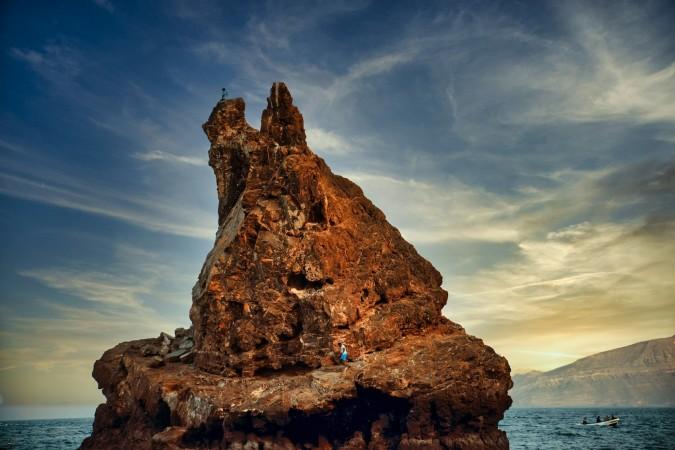
Overview of Sur
History & Cultural Influence in Sur
Sur’s rich history is deeply tied to its position as a prominent maritime hub. For centuries, this city has played a vital role in Omani seafaring, with its strategic location on the Arabian Sea and its proximity to the Indian Ocean. During its peak, Sur was a bustling trade port, where Omani sailors connected with merchants from Africa, India, and Persia. In addition to its seafaring past, Sur’s culture is shaped by a blend of Omani, African, and Indian influences. This cultural fusion can be seen in the city’s architecture, traditional clothing, and even its cuisine.
Interaction with the Locals
The citizens of Sur, known as Suris, are predominantly of Omani descent, with a rich heritage shaped by maritime trade and cultural exchanges with Africa, India, and Persia. Known for their warm hospitality, Suris embraces both traditional values and modern influences. Many locals still engage in traditional crafts, like dhow building, while others work in education, commerce, and fishing. The city's population reflects Oman’s emphasis on preserving culture, while also welcoming visitors and showcasing its unique maritime legacy.
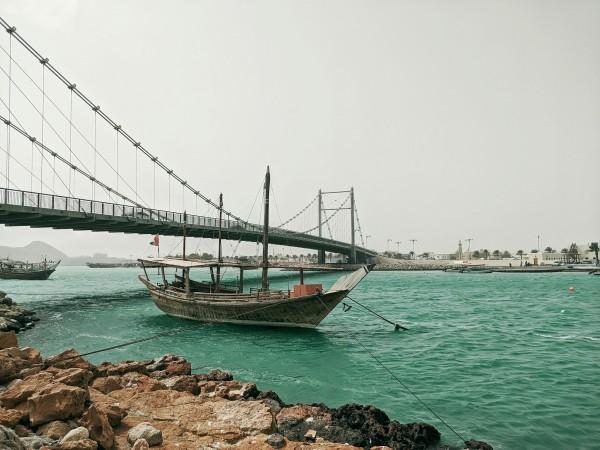
Dhow Shipyard in Sur - © Jithin Daniel James
Top Attractions in Sur
Sur is a treasure trove of attractions that will appeal to history historians, nature lovers, and thrill seekers alike. Each of these must-see sites offers a unique glimpse into the rich history and natural beauty of Sur, ensuring that every traveler leaves with unforgettable memories.
Dhow Shipyard
The Dhow Shipyard in Sur is one of the city’s top attractions, where traditional wooden ships are still constructed by hand. These beautifully crafted boats have been a key part of Omani culture for centuries, and visiting the shipyard gives you a firsthand look at this age-old practice. The sight of craftsmen carefully assembling these vessels is a captivating experience, offering a window into Oman’s seafaring past.
Ras Al Jinz Turtle Reserve
Ras Al Jinz Turtle Reserve, located a short drive from Sur, is a world-renowned breeding location for endangered green turtles. Every year, thousands of these turtles come to the beaches to lay their eggs, giving visitors a unique and wonderful experience. Guided night tours allow tourists to observe this natural wonder in a way that is respectful to the turtles and their environment.
Al Ayjah Lighthouse
The Al Ayjah Lighthouse, located at the entrance to Sur's bay, is the city's famous symbol. It provides beautiful views of the coast, sea, and the medieval settlement of Al Ayjah. The lighthouse is a favorite spot for photographers, especially during sunset when the golden light paints the horizon in stunning hues.
Wadi Shab
For those seeking adventure, a trip to Wadi Shab is a must. This stunning canyon is filled with emerald-green pools, waterfalls, and hidden caves. A short hike through the wadi will lead you to a picturesque swimming spot, making it an ideal destination for hikers and nature lovers.
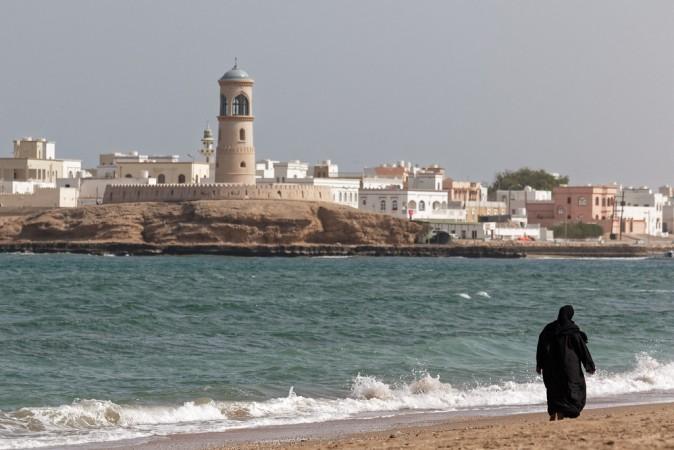
Al Ayjah Lighthouse - © Flickr (@hl_1001)
Must-Try Dishes in Sur
Sur's local cuisine is a delightful reflection of its coastal location and multicultural influences, offering travelers a chance to taste authentic Omani flavors. These dishes reflect the diversity and richness of Sur's culinary traditions, offering travelers an opportunity to experience the authentic tastes of Omani cuisine.
- Shuwa: A signature dish of Oman, Shuwa is a slow-cooked lamb marinated with a rich blend of spices, then wrapped in banana or palm leaves and cooked in an underground sand oven for up to 48 hours. The result is incredibly tender, smoky meat that’s bursting with flavor.
- Majboos: Known for its rich flavors, Majboos (or kabsa) is a spiced rice dish commonly prepared with chicken, lamb, or fish. It is cooked with saffron, cardamom, and other spices, giving it an aromatic and hearty taste. This dish is popular across Oman and is often served during gatherings.
- Omani Halwa: Omani Halwa is a must-try dessert made from sugar, rosewater, saffron, and cardamom. This sticky, gelatinous treat is served with kahwa (Omani coffee) and is a symbol of Omani hospitality. Its rich and fragrant taste makes it the perfect sweet ending to any meal.
- Madrouba: A hearty dish, Madrouba is made by cooking rice with meat (usually chicken or lamb), butter, and spices until the ingredients break down into a smooth, creamy consistency. The dish is mildly spiced and is a comforting, filling option often served at family meals.
- Rukhal Bread: A traditional Omani flatbread, Rukhal is paper-thin and cooked over a hot griddle. It’s typically served with honey, cheese, or dipped in kahwa. It’s a staple in many Omani households and can be enjoyed at any time of the day.
- Luqaimat: A popular dessert, Luqaimat are deep-fried dough balls drizzled with honey or date syrup. These sweet treats are crunchy on the outside and soft on the inside, making them a favorite snack, especially during Ramadan

Luqaimat - © MICHELIN Guide
Festivals & Local Celebrations in Sur
Sur’s calendar is dotted with vibrant festivals and local celebrations that give visitors a unique insight into Omani culture and traditions. These events are often rooted in religion, history, or the maritime traditions that define the city.
Eid Celebrations
Eid al-Fitr and Eid al-Adha are two of the most important religious festivals in Oman and to the Muslim community. During these occasions, the people of Sur gather to celebrate with communal prayers, festive meals, and acts of charity. Visitors can witness the rich cultural displays, from traditional dances to local markets bustling with activity. It’s a time when families come together, and the city's streets fill with joy and festivity.
Traditional Boat Races
Given Sur’s deep maritime heritage, traditional dhow races are a prominent local celebration. Held at different times throughout the year, these boat races bring the community together to cheer on teams of rowers competing in beautifully crafted dhows. These events celebrate Sur’s seafaring history and offer visitors a chance to witness the competitive spirit of the locals while enjoying the festivities surrounding the races.
Cultural Performances
Omani music and dance are integral to local celebrations, and visitors to Sur can experience traditional performances like the Razha, an Omani sword dance accompanied by rhythmic drumming and chanting. These performances often take place during public holidays, weddings, or festivals and provide a lively, immersive experience of Omani folklore.
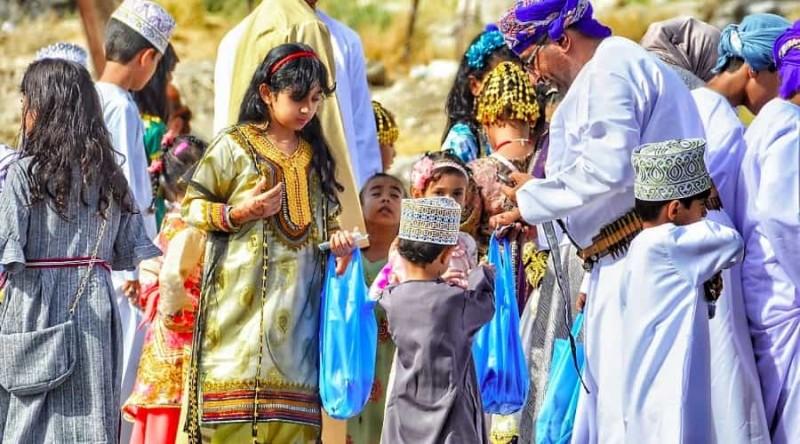
Eid Celebrations in Oman - © Arabian Daily News
What to Do in Sur
- Beach and Water Activities: The pristine beaches are perfect for swimming, snorkeling, or simply relaxing under the sun. Popular beaches like Al Hadd and Ras Al Jinz not only offer stunning views but also opportunities for marine exploration, with clear waters rich in marine life.
- Hiking in Wadi Shab: The beautiful canyon, Wadi Shab, offers a scenic hike through rocky terrain, leading to crystal-clear pools where visitors can swim. The journey through the wadi rewards adventurers with a hidden cave and waterfall, making it a perfect day trip from Sur for those looking to explore Oman’s natural beauty.
- Dhow Cruises: Experience Sur’s maritime history firsthand by taking a dhow cruise along the coast. These traditional boats offer a relaxing way to explore the area, passing by hidden coves, picturesque beaches, and rocky cliffs, and experience a great time of dolphin-watching.
- Cultural Tours: For history buffs, cultural tours around Sur’s ancient landmarks are a must-do. Visit the Sunaysilah Fort and Bilad Sur Castle to learn about the city’s defensive history, or take a guided tour through the Sur Maritime Museum to dive deeper into its seafaring past.
Shopping in Sur
- Local Souqs: Sur’s traditional souqs are a must-visit for travelers looking for unique souvenirs and handcrafted items. Sur Souq is a lively market where you can find silver jewelry, frankincense, perfumes, spices, and traditional Omani clothing. Handmade crafts such as dhow models and pottery are particularly popular with visitors, as they reflect the city’s maritime roots.
- Artisanal Shops: Sur is famous for its intricate silver jewelry and khanjars (traditional Omani daggers), often made by local artisans. These objects are highly valued for their artistry and make ideal keepsakes. The city is also known for its halwa (a traditional Omani sweet), which is available in beautifully packaged boxes and is a favorite gift item.
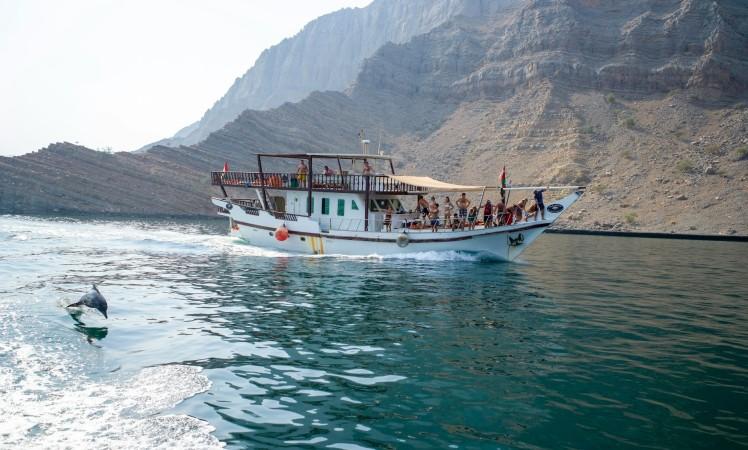
Dolphin-watching right at the coastline of Oman - © Julius Yls
Weather in Sur: Best Time to Visit
Summer in Sur
Sur’s summer months are characterized by intense heat, with average daytime temperatures often exceeding 40°C (104°F) and occasionally reaching as high as 45°C (113°F). Nighttime temperatures remain high, typically between 30°C and 35°C (86°F to 95°F). Due to the extreme heat, outdoor activities during the day are challenging, but water-based activities such as swimming, snorkeling, and diving are still enjoyable, thanks to the cooling effect of the sea.
Winter in Sur
During this season, average daytime temperatures range between 20°C to 30°C (68°F to 86°F), with cooler evenings that can dip to around 17°C (63°F). This period is ideal for hiking in Wadi Shab, exploring the city’s historical landmarks, and relaxing on the beaches. The cooler temperatures and light breezes provide the perfect environment for visiting the Ras Al Jinz Turtle Reserve to witness turtle nesting. Rain is rare but can occur sporadically in the form of brief showers.
Spring and Autumn in Sur
These transitional periods offer fewer crowds and are still suitable for outdoor activities, though midday heat may be slightly more intense. In April, the heat of summer starts to build, with average temperatures ranging from 28°C to 35°C (82°F to 95°F), but evenings remain cooler and more comfortable. Similarly, in October, the weather begins to cool down after the summer heat, with temperatures ranging between 27°C to 33°C (81°F to 91°F).
Monsoon and Khareef Season in Sur
While Sur doesn’t experience heavy monsoons like the southern regions of Oman, it may receive occasional light rain during the summer months, particularly influenced by the Khareef season. This seasonal monsoon typically affects the coastal areas in the south but can bring a bit of relief to Sur as well, making the weather slightly cooler and more humid.
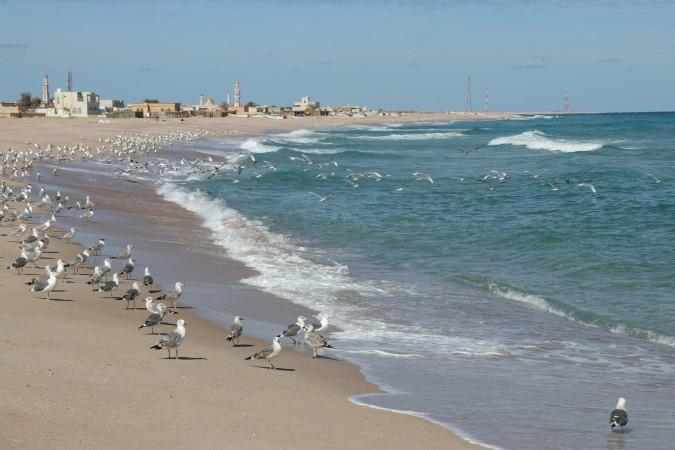
Relaxing at Sur's beaches on a clear day - © Emily Liang
Essential Travel Information
Getting Around Sur
- Taxis: Taxis are a convenient option for getting around the city and can take you to most of the main attractions. If you're staying in the city for an extended period, renting a car remains an excellent option for exploring both Sur and its surrounding areas.
- Walking: Many of Sur’s key attractions, including the Corniche, Al Ayjah Lighthouse, and local souqs, are within walking distance of each other, making it a pleasant city to explore on foot. Walking along the Corniche provides beautiful views of the harbor, traditional dhows, and the surrounding landscape, and is a popular activity for both visitors and locals.
- Boat Tours: Given Sur’s rich maritime history, a traditional boat tour is a fantastic way to see the city from a different perspective. Dhow boat tours are recommended to have a relaxing time along the coastline, where you can enjoy scenic views, visit hidden beaches, or even go dolphin watching.
ATM & Banking Services
Sur offers convenient access to ATM and banking services, ensuring that travelers can manage their finances stress-free. ATMs are widely available in key areas such as the city center and near popular tourist spots, accepting most major international credit and debit cards. It's advisable to carry some local currency, especially when visiting smaller shops or markets, as not all vendors accept cards. Currency exchange services are available at local banks and big hotels, although withdrawing cash from ATMs is often the easiest option.
Where to Stay in Sur
- Luxury Hotels: For travelers seeking a premium experience, Sur provides a selection of luxury hotels that offer amenities like pools, fitness centers, and on-site dining. These hotels frequently have breathtaking views of the coastline or the port, providing guests with an ideal balance of comfort and scenic beauty.
- Mid-Range Hotels: If you're looking for a balance between comfort and affordability, Sur has several mid-range hotels and guesthouses that provide excellent service at reasonable rates. These accommodations often feature modern amenities, such as Wi-Fi and air conditioning, and are located close to popular tourist areas.
- Traditional Omani Guesthouses: For those looking for a more authentic experience, staying in a traditional Omani guesthouse is a great option to experience Omani hospitality firsthand. Staying in a guesthouse allows visitors to immerse themselves in local culture, often with the added benefit of home-cooked meals and personalized recommendations for exploring the area.
Articles for you

Explore Yala National Park - Sri Lanka Travel, Asia
Tucked away in Sri Lanka’s southeastern corner, Yala National Park is where wild nature meets deep tradition. Known worldwide for its leopard population, the park is also home to elephants, sloth bears, crocodiles, and hundreds of bird species. Beyond wildlife, Yala opens doors to a cultural landscape dotted with ancient temples, Buddhist ruins, and coastal villages. For travelers seeking more than just a safari, Yala offers a chance to explore eco-tourism, local communities, and sacred heritage sites.
Population: The Yala National Park area doesn’t have a human population.
Economy: The economy around Yala National Park thrives on a blend of eco-tourism, agriculture, and local services. Safari tours, eco-lodges, and cultural experiences drive steady income for nearby towns like Tissamaharama and Kataragama, supporting thousands of families.
Landmarks: Famous for Block I of Yala and wildlife encounters, including elephants, sloth bears, crocodiles, and exotic bird species.

Explore Galle - Sri Lanka Travel, Asia
Nestled on Sri Lanka’s southern coastline, Galle is a vibrant city where history meets the sea. Its cobbled streets, colonial architecture, and serene beaches make it a must-visit destination for travelers seeking a blend of culture, adventure, and relaxation. A UNESCO World Heritage site, Galle captivates visitors with its Dutch Fort, bustling markets, and friendly locals. Whether you’re exploring the ramparts at sunset or savoring fresh seafood by the shore, Galle promises an unforgettable journey into Sri Lanka’s heritage.
Population: Approximately 113,000 in 2023.
Economy: Galle’s economy thrives on tourism, trade, and fisheries. The city’s historic fort, colonial architecture, and coastal charm draw thousands of international visitors each year, making tourism its main economic driver. Fishing remains vital for local livelihoods, supplying fresh seafood across the region.
Landmarks: Famous for the Galle Fort, Dutch Reformed Church & Maritime Museum, and Unawatuna Beach.

Explore Bentota - Sri Lanka Travel, Asia
Nestled along Sri Lanka’s southwestern coast, Bentota is a tropical paradise that blends golden beaches, vibrant culture, and thrilling adventures. Famous for its calm waters, luxury resorts, and scenic river estuary, Bentota has become a top destination for travelers seeking both relaxation and authentic experiences. From serene beach walks at sunrise to adrenaline-pumping water sports, this coastal town offers a perfect balance of leisure and exploration. With its proximity to Colombo and Galle, Bentota is easy to reach, making it an ideal stop for both short escapes and extended holidays.
Population: Approximately 37,000 in 2023.
Economy: Bentota’s economy thrives mainly on tourism, which drives local businesses such as hotels, restaurants, and wellness retreats. The town also benefits from fishing, coconut cultivation, and handicrafts like wood carving and batik textiles. Many residents rely on the growing demand for water sports and Ayurvedic treatments, making tourism the backbone of both income and employment in the area.
Landmarks: Famous for Bentota Beach, Bentota River Safari, and Kande Vihara Temple.

Explore Mirissa - Sri Lanka Travel, Asia
Mirissa is a charming coastal town on Sri Lanka’s southern shoreline. Known for its golden beaches, turquoise waters, and vibrant marine life, it has become a must-visit stop for travelers exploring the island. Many come for whale watching, surfing, and sunset views at Coconut Tree Hill, but Mirissa offers much more than postcard beauty. The fishing boats you see anchored by the bay carry generations of stories. Local traditions, delicious cuisine, and a laid-back rhythm of life shape every visitor’s experience.
Population: Approximately 4,700 in 2023.
Economy: Mirissa’s economy is largely shaped by its coastal location. Fishing has long been the backbone of local livelihoods, with generations relying on the Indian Ocean for income. In recent decades, tourism has become the main driver of growth, thanks to whale watching, surfing, and beachside hospitality.
Landmarks: Famous for Mirissa Beach, Coconut Tree Hill, and Parrot Rock Bridge.

Explore Nuwara Eliya - Sri Lanka Travel, Asia
Tucked away in the Central Highlands of Sri Lanka, Nuwara Eliya is often called “Little England”. With its rolling tea plantations, cool misty mornings, and colonial charm, this mountain town feels like a step into another world. Travelers come here to breathe fresh air, walk through flower gardens, sip the finest Ceylon Tea, and enjoy a pace of life far from the island’s busy cities. Whether you’re drawn by scenic landscapes, heritage architecture, or the warmth of its people, Nuwara Eliya is a destination that blends nature, culture, and history in perfect harmony.
Population: Approximately 781,000 in 2023.
Economy: Nuwara Eliya’s economy thrives mainly on tea production, as it sits in the heart of Sri Lanka’s central highlands, famous worldwide for Ceylon Tea. The city also benefits from a growing tourism industry, attracting visitors with its colonial charm, cool climate, and scenic landscapes.
Landmarks: Famous for Gregory Lake, Hakgala Botanical Garden, and Victoria Park.

Explore Sukau - Malaysia Travel, Asia
Nestled on the banks of the Kinabatangan River in Sabah, Malaysian Borneo, Sukau is a destination where wildlife, culture, and conservation come together. Known as one of Asia’s top spots for river safaris and eco-tourism, this quiet village offers a front-row seat to encounters with Bornean orangutans, pygmy elephants, proboscis monkeys, and exotic birdlife.
Population: Approximately 1,400 in 2019.
Economy: Sukau’s economy is shaped by its riverine location and natural resources. Traditionally, the Orang Sungai community relied on fishing, small-scale farming, and forest gathering for their livelihood. Today, the village has shifted toward eco-tourism, with river cruises, jungle trekking, and homestays providing income.
Landmarks: Famous for the Kinabatangan River cruises, Gomantong Caves, and Ox-bow lakes and wetlands.
